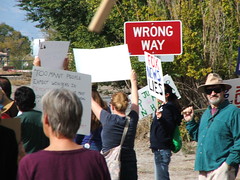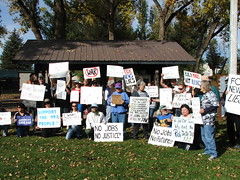Nathan Crites-Herren
The Paw Print

Photo by Melissa Skinner: Alamosa suppporting "Occupy Wall Street"
Over the past two months the grass roots movement known as Occupy Wall Street has been gaining popular support, not only nationally, but internationally as well. The roots of this broad based movement grew out of New York citizens deciding to continuously occupy the Manhattan finical district. The encampment, based at Zuccotti Park which was renamed by protesters as Liberty Plaza, has been the base of protesters operations.
Since its humble beginnings, the movement has expanded its influence well outside the New York borders inspiring similar occupations throughout the country. From Washington DC, Oakland, Chicago, Charlotte to Denver and even in Alamosa there has been solidarity actions with the Occupy Wall Street movement. In addition, international solidarity actions continue to take place in cities across the globe, with the most vibrant ones in Paris, Tokyo, Rome and Buenos Aires. Hundreds of protesters have been arrested throughout the nation and globe as police response continues to grow in hostility.

Photo by Melissa Skinner
The demands of this global movement are diverse, but are centralized around a common theme that seeks to expose the ongoing corruption of governments, corporations and those in positions of power while articulating new visions for democracy. “I think the change is coming from us. It’s coming from the change in our way of thinking and living. I think this is a chance for everyone to wake up and think about what actually they want and how do they want the world to be and what do they want to do to make the world a better place,” said Julian Assange, activist and founder and editor of the web site Wiki Leaks.
“Usually, before Occupy Wall Street, people go out and protest, they have their signs, they have their chants, and then they pick up their stuff and go home. But this is the first time that there’s been a real movement, in my lifetime, where we see the same people coming out day after day. We see labor unions and student groups and other community organizing groups come together. And they stay. They keep coming back. They’re keeping up the fight. So it’s something that in my life I feel has no precedent,” said Julie Gonzales, director of organizing for the Colorado Immigrant Rights Coalition and one of many organizers of the Occupy Wall Street demonstration in Colorado.
Overall, the demonstrations have been peaceful with the majority of violence coming from police in their efforts to clear streets and the numerous parks being occupied. There are other protesters who felt that the system only responds to violence. These protesters have lead open confrontations and attacks against police in numerous cities. “We are a diverse group of people and some of us feel that violence is an appropriate response to the injustices we face, although the majority does not participate in this violence we have to understand it,” said Vincenzo Fiore, Italian activist and member of the left-wing party Sinistra Ecologia e Libertà.
Demonstrators say that the Occupy Wall Street movement is the western response to the Arab Spring that brought about immense political and social change in countries like Libya, Egypt and Syria. On Oct. 17, Dr. Cornel West, professor at Princeton University was arrested at the Martin Luther King Jr. Monument in Washington DC while giving a speech declaring that the “Peoples Spring” has begun. “We’re here to bear witness with, to be in solidarity with the Occupy movement all around the world, because we love poor people, we love working people, and we want Martin Luther King, Jr., to smile from the grave that we haven’t forgot his movement,” said West.
Popular energy continues to foster further action as the movement shows no signs of compromise or slowing down. According to demonstration organizers, protesters will not only continue to occupy Liberty Plaza but the peoples of the countless cities nation and worldwide will endure their own united struggles.

Photo by Melissa Skinner
What’s Been Said…